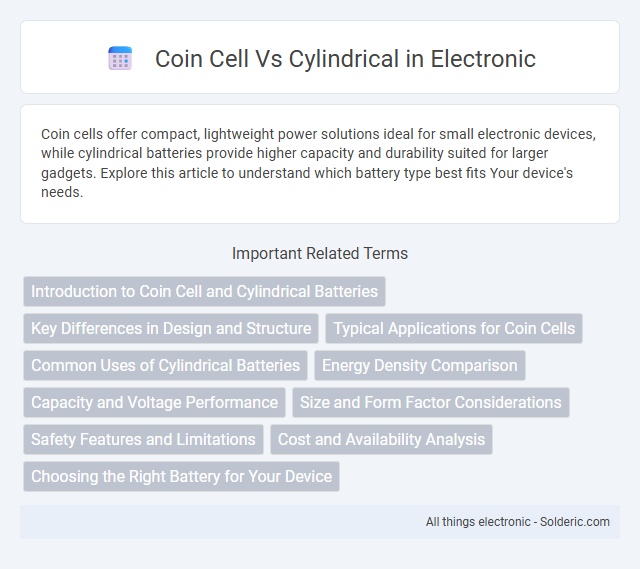Coin cells offer compact, lightweight power solutions ideal for small electronic devices, while cylindrical batteries provide higher capacity and durability suited for larger gadgets. Explore this article to understand which battery type best fits Your device's needs.
Comparison Table
| Feature | Coin Cell | Cylindrical Cell |
|---|---|---|
| Shape | Flat, round, disc-shaped | Cylindrical, tube-shaped |
| Size | Small, thin (e.g., 20mm diameter, 3-5mm thickness) | Larger, varying diameters (e.g., 18mm, 21mm, 26mm) and lengths (e.g., 65mm) |
| Voltage | Typically 3V (Lithium), 1.5V (Alkaline) | Typically 3.6-3.7V (Li-ion) |
| Capacity | Low (20-300mAh) | High (500-3500mAh+ depending on size) |
| Applications | Small electronics: watches, calculators, hearing aids | Power tools, laptops, e-bikes, electric vehicles |
| Rechargeability | Mostly non-rechargeable (primary), few rechargeable variants | Primarily rechargeable (secondary) |
| Energy Density | Lower energy density | Higher energy density |
| Cost | Generally low cost | Higher cost due to capacity and features |
Introduction to Coin Cell and Cylindrical Batteries
Coin cell batteries are compact, flat, and disc-shaped power sources commonly used in small electronic devices like watches and hearing aids, offering reliable energy in a tiny form factor. Cylindrical batteries have a tubular shape and are widely found in applications such as flashlights, laptops, and electric vehicles, providing higher capacity and discharge rates. Choosing the right type depends on your device's size constraints and power requirements.
Key Differences in Design and Structure
Coin cells feature a flat, disc-like shape with a compact form factor ideal for small electronic devices, while cylindrical batteries have a tubular design offering higher capacity and better heat dissipation. Coin cells use pressed powder electrodes with a button shape that optimizes space efficiency, whereas cylindrical cells utilize wound electrodes within a metal casing for enhanced mechanical stability. The structural design of coin cells prioritizes portability and low current applications, contrasting with cylindrical batteries' suitability for high current and longer runtime scenarios.
Typical Applications for Coin Cells
Coin cells are commonly used in small, low-drain electronic devices such as watches, hearing aids, remote controls, and small medical devices due to their compact size and long shelf life. These batteries provide reliable power in applications where size constraints and lightweight design are critical, making them ideal for wearable technology and small sensors. Your choice of a coin cell ensures efficient energy delivery in devices requiring stable voltage over extended periods without frequent replacement.
Common Uses of Cylindrical Batteries
Cylindrical batteries are widely used in power tools, electric vehicles, and flashlights due to their high energy density and durability. Their standardized sizes, such as 18650 and 21700, make them ideal for laptop batteries and portable electronic devices. These batteries provide reliable performance in high-drain applications and are favored for modular battery pack designs.
Energy Density Comparison
Coin cells typically offer higher energy density by volume compared to cylindrical cells, making them ideal for compact electronics such as watches and hearing aids. Cylindrical cells generally provide greater energy capacity by weight and support higher discharge rates, suitable for power-demanding devices like flashlights and power tools. The choice between coin and cylindrical cells depends on balancing volumetric energy density with application-specific power requirements.
Capacity and Voltage Performance
Coin cells typically offer lower capacity and voltage compared to cylindrical cells, making them suitable for low-drain devices such as watches and small electronics. Cylindrical batteries provide higher capacity and more stable voltage output, which supports demanding applications like power tools and electric vehicles. Your choice depends on balancing size constraints with the need for sustained energy and voltage performance.
Size and Form Factor Considerations
Coin cells offer a compact, flat design ideal for small devices requiring minimal space, typically measuring 5 to 25 millimeters in diameter and 1 to 6 millimeters in height. Cylindrical cells range from small 9-volt batteries to larger AA or 18650 sizes, providing greater capacity but occupying more volume with lengths from 14 to 70 millimeters and diameters between 10 and 22 millimeters. Selecting between coin and cylindrical cells hinges on balancing device size constraints against energy needs, with coin cells favored for slim, portable electronics and cylindrical cells for higher power applications.
Safety Features and Limitations
Coin cell batteries offer compact size and stable voltage output but have limited capacity and higher risk of leakage if punctured or improperly handled. Cylindrical batteries provide greater energy density and built-in safety mechanisms such as venting systems and thermal fuses to prevent overheating and short circuits. While cylindrical cells are bulkier, their robust construction enhances safety in high-drain applications compared to the more fragile and pressure-sensitive coin cells.
Cost and Availability Analysis
Coin cells generally offer lower initial costs and are widely available for small electronic devices, making them a cost-effective choice for low-drain applications. Cylindrical batteries, particularly popular sizes like 18650 and 21700, have a higher upfront price but provide greater energy capacity and longer lifespan, which can reduce overall replacement frequency and cost for high-drain devices. Market availability for coin cells is robust across consumer electronics, while cylindrical cells dominate power tools, electric vehicles, and drones, reflecting their distinct usage and cost dynamics.
Choosing the Right Battery for Your Device
Coin cells offer compact size and long shelf life, ideal for small electronics like watches and calculators, while cylindrical batteries provide higher capacity and consistent power output, suitable for devices demanding more energy such as flashlights and power tools. Your choice depends on the device's size constraints and power requirements, ensuring optimal performance and longevity. Evaluating voltage, capacity (mAh), and discharge characteristics helps select the most efficient battery type for your technology.
Coin cell vs Cylindrical Infographic

 solderic.com
solderic.com